Recording a Lecture or Seminar

Recording a Lecture or Seminar
At one time or another we have probably stepped up to a podium and given a prepared statement or two, whether it be to share some kind words to a married couple, to read scripture at church or to deliver a lecture to professionals in a given field. There exists many different ways to record speech, and in this article I'm going to give a brief overview of the resources you have at your disposal.
The audio setup and PA system of a given public address event will vary widely according to the venue. In general you won't have trouble finding a way to record your public speaking engagements so long as you ask the event coordinator about the microphone setup they use beforehand. If you want really good sound, I suggest inputting your recorder into a soundboard or similar device that controls the event’s microphone amplification.
One thing I'd like to press proceeding is the importance of micing audience members if you have a question and answer period. Usually this involves having audience members go up to a microphone to ask their question and recording that audio from the same soundboard you are using to record your own voice. Bear in mind however that this isn't always possible. Nevertheless I do think it is an important element in your production when you finally put it together and let people hear it.
Part I: Recording Devices
While preparing this article, I had to decide if I was going to put an emphasis on digital recording over analogue. In many ways, the digital options have increased sound quality on such a dramatic scale that it's become almost impossible to give a full recommendation to the humble cassette recorder from antiquity. Only time will tell if analogue systems are truly dead. As of right now, they are still something people turn to thanks in no small part to their reliability.
Cassette Recorders
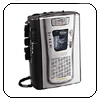 A Sony Walkman recorder is one of the most basic ways to get your speeches recorded. In many ways I'm hesitant to recommend this as a recording option, but many pro's still argue its merits. Problems with copy protection have become a real roadblock when it comes CD-R recording, and you can't complain with how easy it is to record to a cassette. Let's just put it this way, I've heard many homemade lecture recordings made with a walkman, but I probably wouldn't buy one. If you plan on using this device, I highly recommend purchasing High-Bias cassettes such as the Type II Metal tapes put out by Maxell. I used one of these cassettes while I was doing field recording in school and my teacher at the time said it is possible to get a good recording if you mic correctly.
A Sony Walkman recorder is one of the most basic ways to get your speeches recorded. In many ways I'm hesitant to recommend this as a recording option, but many pro's still argue its merits. Problems with copy protection have become a real roadblock when it comes CD-R recording, and you can't complain with how easy it is to record to a cassette. Let's just put it this way, I've heard many homemade lecture recordings made with a walkman, but I probably wouldn't buy one. If you plan on using this device, I highly recommend purchasing High-Bias cassettes such as the Type II Metal tapes put out by Maxell. I used one of these cassettes while I was doing field recording in school and my teacher at the time said it is possible to get a good recording if you mic correctly.
Minidisc Recorders
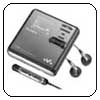 MiniDisc Recorders mix the capabilities of a cassette recorder with the sound quality of a compact disc. They were invented by Sony as a replacement for the popular cassette recorders of the 70's and 80's and have been used regularly by amateur recordists throughout the 90's. My first exposure to digital recording came with MD and for a time it was my primary mobile recording option until the advent of the iRiver. You can basically put any microphone you wish into the jack, place the MD in your pocket and enjoy CD-Quality recordings. The major issue I have with the old MD recorders comes when you transfer your material to a computer. With the older model MD recorders (1993-2004) you have to use computer software like Audacity to record all of your MD recordings in real time; you can't "copy and drag" your media! The process of re-recording your MD recordings (does that make sense?) results in a loss of quality. While this loss is negligible, it's still a loss you wouldn't have were you able to copy and paste the digital file directly. I bring this problem with the older MD recorders up only because you may want to buy one used; largely they have been replaced by the newer Hi-MD recorder. The H-MD's are a total revamp of the whole MD concept. Released in 2004, they offer a larger recording capacity and feature a USB interface that allows you to drag your material directly. The downside is that they cost a bit more and the lowest I've seen one of these devices going for is about 200 bucks. The most popular model used by podcasters and for speech recordings is the Sony MZ-RH10.
MiniDisc Recorders mix the capabilities of a cassette recorder with the sound quality of a compact disc. They were invented by Sony as a replacement for the popular cassette recorders of the 70's and 80's and have been used regularly by amateur recordists throughout the 90's. My first exposure to digital recording came with MD and for a time it was my primary mobile recording option until the advent of the iRiver. You can basically put any microphone you wish into the jack, place the MD in your pocket and enjoy CD-Quality recordings. The major issue I have with the old MD recorders comes when you transfer your material to a computer. With the older model MD recorders (1993-2004) you have to use computer software like Audacity to record all of your MD recordings in real time; you can't "copy and drag" your media! The process of re-recording your MD recordings (does that make sense?) results in a loss of quality. While this loss is negligible, it's still a loss you wouldn't have were you able to copy and paste the digital file directly. I bring this problem with the older MD recorders up only because you may want to buy one used; largely they have been replaced by the newer Hi-MD recorder. The H-MD's are a total revamp of the whole MD concept. Released in 2004, they offer a larger recording capacity and feature a USB interface that allows you to drag your material directly. The downside is that they cost a bit more and the lowest I've seen one of these devices going for is about 200 bucks. The most popular model used by podcasters and for speech recordings is the Sony MZ-RH10.
Hard-Disc Recorders
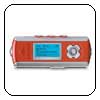 This type of recorder has become a huge option for anyone that needs to record audio on the go. They allow users to record directly to a small USB mass storage hard disk, like an iPod or more notably the iRiver. A good portion of podcasters have taken to the iRiver in particular because of its extreme portability, high quality recording capabilities and direct access to media via USB. I recommend looking into the 700 Series of recorders, which captures your voice to a Flash drive and comes in models that can store up to 1GB of mp3 audio. I have personally heard amazing "sound-seeing" recordings made in the field with the iRiver and its size makes it perfectly suited for any corporate environment. This type of recorder has quickly risen in popularity and would work perfectly in combination with a Lavalier microphone.
This type of recorder has become a huge option for anyone that needs to record audio on the go. They allow users to record directly to a small USB mass storage hard disk, like an iPod or more notably the iRiver. A good portion of podcasters have taken to the iRiver in particular because of its extreme portability, high quality recording capabilities and direct access to media via USB. I recommend looking into the 700 Series of recorders, which captures your voice to a Flash drive and comes in models that can store up to 1GB of mp3 audio. I have personally heard amazing "sound-seeing" recordings made in the field with the iRiver and its size makes it perfectly suited for any corporate environment. This type of recorder has quickly risen in popularity and would work perfectly in combination with a Lavalier microphone.
Laptop Recording
Ok, let's say you would rather plug your mic directly in to your laptop (which you can conceal underneath the podium maybe?). This is conceivable, but obviously prohibitive. To record quality audio, you'll need some sort of intermediary to boost the signal from your microphone. There are many devices that let you do this, and they usually come bundled with an analogue to digital converter. Microphone inputs on a laptop simply aren't sensitive enough to enable a recording that is rich or loud. I recommend a buying a USB powered audio to midi interface device like the one LearnOutLoud uses for it's podcasts, the Tascam USB-122. With this piece of hardware, you can input any microphone you have, boost the mic’s signal and then send that signal to their laptop via a USB cable. A new alternative is to purchase a USB microphone, which you can connect directly to your Laptop's USB port, thereby bypassing the need for a Tascam. None of these items will allow you to walk around however.
PART II: Microphones
Be sure that you pay attention the connectors you need when you buy your equipment. The most common connector's are (in order of sized small to large), the 1/4" (mini) connector, the 1/8" connector and finally the XLR connector. XLR's are the most stable connectors to use for microphones, so you may want to search out interfaces that use them. For the most part you will usually be dealing with mini connectors, but it varies depending on either what gear you are buying or what the location provides for you. Save a trip to Radioshack for adapters by making sure you know what connectors you need.
For a good overview of the different types of microphones you will likely encounter, go over to the ever trusty Wikipedia: http://en.wikipedia.org/wiki/Microphone
Unidirectional Microphone
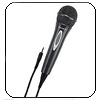 When talking about the first tier microphones, the ubiquitous Unidirectional Microphone is the one everyone knows by sight. You will see this guy at the majority of public spaces and you'll have to be prepared to work with them in most cases. If you can use a lapel mic for your recording, I would go for that instead, but in many ways, these handheld mics are so standard that their unavoidable. To this day I will still recommend Sony's F-V320, which we used at LearnOutLoud.com for our podcasts early on.
When talking about the first tier microphones, the ubiquitous Unidirectional Microphone is the one everyone knows by sight. You will see this guy at the majority of public spaces and you'll have to be prepared to work with them in most cases. If you can use a lapel mic for your recording, I would go for that instead, but in many ways, these handheld mics are so standard that their unavoidable. To this day I will still recommend Sony's F-V320, which we used at LearnOutLoud.com for our podcasts early on.
Lavaliers
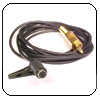 Next up is everyone's favorite, the lavalier! These minature mics are the standard for public speaking and rightfully so as they provide an amazing amount of bang for such a small package. Famously these mics allow absolute hands-free use and can be hidden by clothing or clipped to a tie. One of these guys with an iRiver makes for a great 1-2 mobile speech recording combo. Most people wouldn't even know you have a mic on you! For a particular model I would recommend looking into this model put out by Giant Squid Audio Lab, which is perfect for business meetings.
Next up is everyone's favorite, the lavalier! These minature mics are the standard for public speaking and rightfully so as they provide an amazing amount of bang for such a small package. Famously these mics allow absolute hands-free use and can be hidden by clothing or clipped to a tie. One of these guys with an iRiver makes for a great 1-2 mobile speech recording combo. Most people wouldn't even know you have a mic on you! For a particular model I would recommend looking into this model put out by Giant Squid Audio Lab, which is perfect for business meetings.
USB Mics
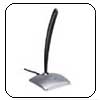 OK, so you don't want to get an iRiver, a minidisc or a walkman and you'd rather look into utilizing your powerbook. I'm glad to say there's another option for you: a USB microphone. This is a great new mic that allows you to jack yourself in directly to a computer via a USB cable. At an average rate of $20, it may be more cost effective to track one of these guys down if you already have a laptop. Bear in mind however that the venue you are speaking at may not allow to use your own mic, and that would leave you high and dry if you only have a laptop as a recording device (then again, a phone call to whomever is setting up the PA system would probably clear the situation up in most cases). This model put out by Logitech is something I've seen around quite a bit and is popular with podcasters.
OK, so you don't want to get an iRiver, a minidisc or a walkman and you'd rather look into utilizing your powerbook. I'm glad to say there's another option for you: a USB microphone. This is a great new mic that allows you to jack yourself in directly to a computer via a USB cable. At an average rate of $20, it may be more cost effective to track one of these guys down if you already have a laptop. Bear in mind however that the venue you are speaking at may not allow to use your own mic, and that would leave you high and dry if you only have a laptop as a recording device (then again, a phone call to whomever is setting up the PA system would probably clear the situation up in most cases). This model put out by Logitech is something I've seen around quite a bit and is popular with podcasters.
CONCLUSION
So after going through all of these examples and considering the products best suited to you, what seems to be the obvious choice? Of course it will vary from person to person according to situation. If one were to ask me what configuration I would choose, I'd have to go with an iRiver IFP 790 in conjunction with a lavalier lapel mic. This would allow me to move around and disguise the fact that I'm recording. I also wouldn't have to worry about soundboards or using the venue's microphone system. All I'd have to do is show up with my own system and record whenever I wished at the click of a button.
I hope this guide has given you a good idea of your current options and that you use this as a springboard to start recording right away. Everything has become so cheap and user friendly lately that recording quality audio is no longer the domain of the pros.